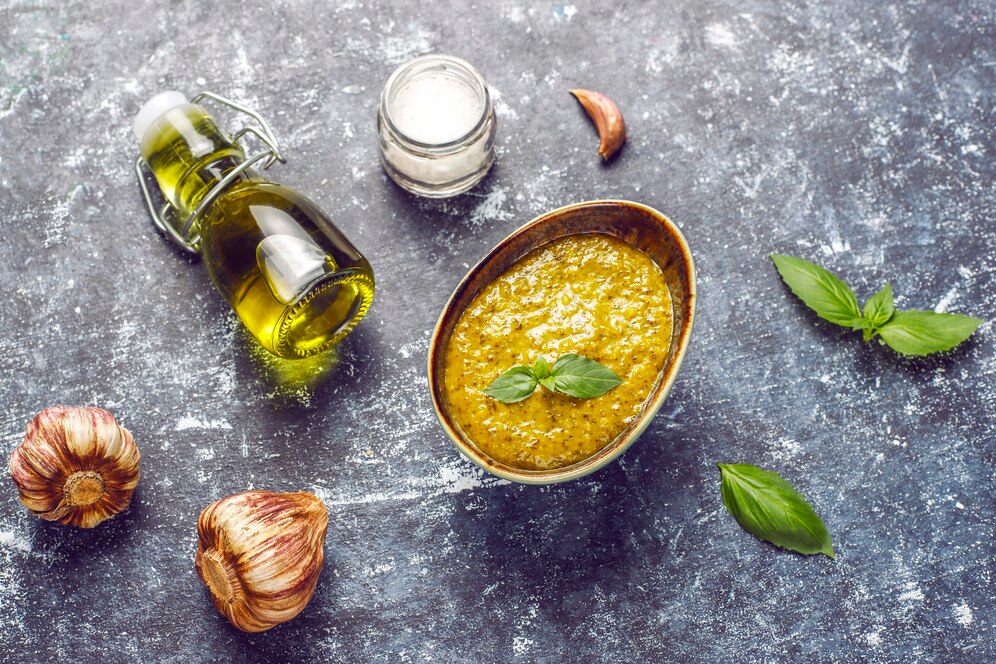Pesto is a beloved sauce that’s known for its fresh, herbaceous flavor, typically made with basil, garlic, pine nuts, Parmesan, and olive oil. However, if you’re looking to try something a little different, consider making a Tahini Pesto. This variation swaps traditional ingredients for the creamy, nutty goodness of tahini, offering a smooth, rich texture and a distinct flavor that pairs wonderfully with pasta, roasted vegetables, sandwiches, and more. Here’s how to make this simple yet delightful twist on a classic pesto.
Ingredients:
- 1 cup fresh basil leaves, packed
- 2 tablespoons tahini (sesame paste)
- 2 tablespoons olive oil
- 1 tablespoon lemon juice (freshly squeezed)
- 1–2 garlic cloves (depending on your preference)
- 1/4 cup pine nuts (or substitute with walnuts or almonds)
- Salt and pepper, to taste
- 2–3 tablespoons water (to adjust consistency)
Instructions:
- Prepare the Ingredients: Begin by washing and patting dry the basil leaves. If using whole garlic cloves, peel them. Measure out the tahini, olive oil, lemon juice, and pine nuts. Having all ingredients ready will make the process smoother.
- Blend the Basil and Nuts: In a food processor or high-speed blender, add the basil leaves and pine nuts. Pulse a few times to break them down into small pieces. This will create the base of your pesto and ensure the ingredients are evenly blended.
- Add the Wet Ingredients: Add the tahini, olive oil, and lemon juice to the food processor. The tahini will provide a creamy base, while the lemon juice will brighten the pesto with a touch of acidity. Add garlic at this point, starting with one clove, and taste afterward to determine if you want to add more.
- Blend Until Smooth: Pulse the mixture several times, scraping down the sides of the food processor as needed. Once everything is well combined, check the consistency. If the pesto is too thick, add water a tablespoon at a time until it reaches your desired texture. The pesto should be smooth and creamy, but still thick enough to coat your food.
- Season to Taste: Taste your pesto and season with salt and pepper to your liking. You may want to add a little more lemon juice for extra brightness or more tahini for a richer flavor. Blend again to incorporate the seasoning.
- Serve and Enjoy: Your tahini pesto is now ready to use! Toss it with freshly cooked pasta, drizzle it over roasted vegetables, or use it as a spread for sandwiches and wraps. It also makes a great dip for crackers or fresh vegetables.
Tips for Customization:
- Nuts: While pine nuts are traditional in pesto, you can experiment with other nuts such as almonds, walnuts, or cashews to create a unique flavor.
- Cheese: If you’re not vegan or dairy-free, you can add a small amount of grated Parmesan or nutritional yeast for a cheesy taste. Nutritional yeast is an excellent dairy-free option.
- Herbs: Basil is the classic herb in pesto, but you can mix it up by adding a bit of parsley, mint, or even spinach for a different flavor profile.
- Spices: For an extra layer of complexity, try adding a pinch of red pepper flakes for a little heat or cumin for a smoky touch.
Why Try Tahini Pesto?
Tahini pesto offers a creamy, nutty twist on a beloved classic. The tahini adds a richness that’s slightly different from the typical pesto but still satisfying and flavorful. The texture is smooth and silky, making it perfect for everything from pasta dishes to vegetable bowls. It’s also an excellent option for those looking for a dairy-free or vegan pesto that still delivers the same satisfying depth of flavor.
With its versatile nature, this tahini pesto recipe can become a staple in your cooking routine, offering a delicious, healthy alternative to the traditional basil pesto. Whether you use it to dress up pasta, drizzle it over grilled chicken, or add it to a veggie-packed sandwich, this creamy and flavorful sauce will quickly become a favorite in your kitchen.








